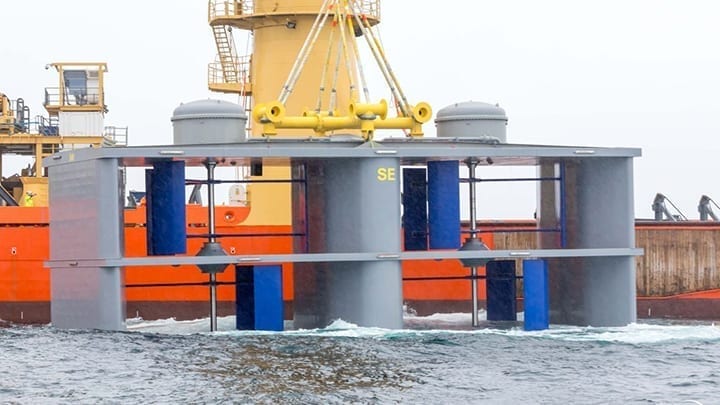Gravity Base Ballast Provides Tidal Turbines with a Sturdy Grip
Offshore wind turbines deliver a strong promise in today’s tough times of climate changes’ debate. The rapid development of the sector favors the need for new gravity concepts. Besides design, ballast is a critical element responsible for the turbine’s stabilization and therefore its success. Its quality, density, and weight, defined by the material choice and the conception, contribute to the performance level of the entire system.
Material Choice: Concrete Is Challenging, Cast Iron Is Better
Despite different technical issues and a medium level of maturity, tidal energy can be a really promising technology once coupled with other renewable energy sources to obtain a comprehensive energy mix. However, the technology still requires innovations for both improving its reliability but also its cost competitiveness.
As part of the system’s potential improvement, the foundation can feature great innovations. Gravity-based foundations offer a stabilization solution highly appreciated for its easy installation in water depth of 20 meters to 80 meters, especially in challenging environments with tight operation windows, heavy currents, and high waves.
Current projects with gravity-based foundations include HydroQuest (Figure 1), Meygen, Sabella, and Guinard Energies. Seeking new and innovative solutions, all of them have been equipped with cast iron ballast. The commonly used concrete has too big volume, which induces the need for bigger vessels and heavier lifting means. The hydrodynamic loads applied during the installation and in operational conditions are also higher due to the most important contact area. Finally, the use of concrete and low-density ballast causes an important footprint on the seabed. Therefore, the majority of the companies have decided to replace it with cast iron ballast, which features the following advantages:
- Minimized seabed footprint.
- Reduced submerged volumes.
- Minimized surfaces exposed to hydrodynamic forces.
- Optimized transport and logistics cost.
- Foundation design optimization thanks to various shapes, assembly, and lifting/handling means of the ballasts.

In general, compared to concrete, cast iron is up to three times denser, and, therefore, can deliver a much more compact solution, allowing a significant volume and weight reduction. Some of the most promising tidal sites, such as Le Ratz Blanchard in France or the Bay of Fundy in Canada, feature very harsh conditions with huge waves and tides. Thanks to the hydrodynamic load reduction, coupled with the limited volume of the cast iron ballast, the solution can result in a reduction of the needed weight, from three to seven times.
Common Applications of Gravity-Based Foundations
HydroQuest, in partnership with CMN (Constructions Mécaniques de Normandie) has deployed on April 26 and 28, 2019, a 1-MW tidal turbine in the waters near Paimpol-Bréhat in Brittany, France. The vertical-axis turbine has been kept until now in place, using a gravity-based foundation. FMGC, the European leader in the manufacturing of cast iron counterweights and a known supplier of innovative ballast solutions for the marine renewable sector, has been assigned by CMN and HydroQuest with the design, development, manufacturing, and delivery of the gravity base ballast and associated accessories, aiming at stabilizing the tidal turbine and preventing it from overturning or sliding (Figure 2).

In this project, the ballasting system has been based on an assembly of hundreds of tons ballast stacked around steel insert. The steel inserts ensure the most efficient assembly of the ballasting system. At the same time, they ease as well the lifting and installation operations, and thus, limit the mobilization time of the vessels and teams both on dock and offshore.
Prior to the manufacturing of the first inserts, a finite element analysis was performed in order to confirm their ability to meet the mechanical solicitations in operational conditions. Once the steel inserts were manufactured, FMGC achieved proof load tests, with more than 450 tons of load applied during the process.
Another example of the successful application of cast iron gravity base ballast is the tidal turbine P154 from Guinard Energies, deployed in 2019 in the Etel Ria (Britanny). Guinard Energies also chose the cast iron to ensure the stabilization of the platform and the turbine itself. The ballasting solution, developed by FMGC, is directly connected to the substructure and is stabilizing the turbine during operational conditions.
European key tidal projects represent a challenging and demanding sector where all involved solutions should be dynamic and easily adaptable to the various designs. Cast iron ballast can be tailored to provide specific shapes and weights, and reach up to 16 tons per unit and compose assemblies up to hundreds of tons.
The HydroQuest and the P154 tidal turbines confirm once again the important role and efficiency of cast iron in offshore applications, but also how a tailored design worked in close collaboration with the developer ensures the efficiency and optimization of the system at every step of the project. Ingenious solutions with no impact on the environment are not necessarily the most expensive ones. Combining simple design with expertise should be the motors of innovation.
—Ralitsa Peycheva is a technical content manager at FMGC.